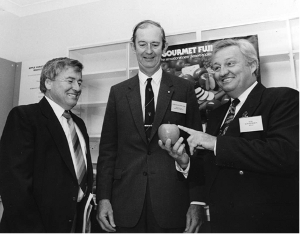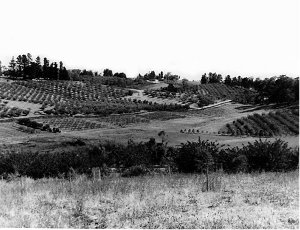Lenswood Horticulture Centre
From early settlement, South Australia’s apple and cool climate fruit industries were established across the Coromandel Valley, Blackwood, Ashton, Summertown, Uraidla, Lenswood, Woodside, Gumeracha, Cudlee Creek, Houghton, Paracombe, Kersbrook, Clare, Wirrabara districts. However, during the 1940s and 1950s, production in the southern hills around Blackwood and Coromandel Valley declined significantly. This meant the Blackwood Experimental Orchard (established in 1908) was no longer well positioned to undertake research for cool climate orchards.
In August 1963, the Department of Agriculture purchased an orchard property from Mr B.A. Fullston which had access from Collins Hill Road at Lenswood. A second adjoining partly developed property belonging to Mr Ronald Jones, and facing onto Swamp Road (approximately 3 km south of the Lenswood township) was purchased in December 1967 (part Sections 92 and 93, Hundred of Onkaparinga). These two properties comprised a total of 70 ha (of which 39 ha was suitable for cropping).
This land was developed to establish the Lenswood Research Centre for serving cool temperate horticulture industries. Planting of new experimental orchards commenced in the winter 1965 with the appointment of Hugo van Dam as Technical Officer.
Gradually the large collection of apple and pear varieties growing at Blackwood was transferred and planted at Lenswood. Other orchards, packing shed, glasshouse, workshop, windbreaks, dams and irrigation infrastructure were gradually developed through the late 1960s, 1970s and 1980s. This development occurred under the early guidance of Bill Harris and Tom Miller until the first Research Officer Barry Windle, was located at Lenswood in 1971.
By April 1968, a house had been constructed for the Technical Officer, and this also served as the first office. A 36 X 9 m machinery, workshop and storage shed, and 9 X 9 m fruit fly storage shed were built in 1967. The small propagation glasshouse located at Blackwood was moved to Lenswood in the early 1970s.
The original properties had two 13,500 kL dams, and two bore pumps. Considerable upgrading of the water storages and distribution network occurred over the next 20 years to enable irrigation of the expanded plantings.
Initially 6.5 ha of apples and 0.4 ha of pears were planted on part Section 93 in 1965, 1966 and 1967. These comprised 3 major trials and 3 variety collections. In 1967, part Section 92 comprised approximately 6.0 ha of old, generally neglected apple and stonefruit plantings, 2 ha of which was being leased to the original owner.
The Senior Research Officer (Horticulture), Mr W.B. Harris in his 1968 proposal for development of Lenswood Horticulture Centre established a timetable and strategy for development of the property. This proposal identified 14 blocks and planned expansion of plantings to 14.2 ha of bearing orchard by 1978.
Original aerial photo of Lenswood Horticulture Centre property – April 1968 ().
Much of the Blackwood Experimental Orchard property was transferred to the Woods & Forests Department in March 1968. The propagation and quarantine glasshouse from Blackwood was rebuilt at Lenswood in 1974. Blackwood was finally closed in the mid 1970s after the research cool room programs were transferred to Northfield Research Centre.

Technical Officer Mr Hugo van Dam taking weather readings, January 1973.
Early Development of Lenswood Programs
Technical Officer Hugo van Dam designed and planted a block of the Dutch Spindle Bush orchard system on M9 dwarfing rootstock late in the 1960s which later was very important in demonstrating the principles of intensive fruit production. Bill Harris designed the first large scale randomized block trial of Malling Merton rootstocks in the late 1960s and Barry Windle developed systems approaches to intensive apple production in the 1970s that were later also successfully applied to cherries.
Other officers that increasingly used Lenswood as an operational base for tree crop research in the 1970s included Lou McMaster, Dr Paul Madge (Entomology), Dr Trevor Wicks (Pathology), Dr Ben Robinson (Nutrition).
Ian Lewis was the first Extension Officer to work out of Lenswood Centre. During the late 1970s, the Centre embarked on a concerted effort to introduce intensive orchard systems into the Adelaide Hills. Following his Lincoln College study, Ian Lewis introduced a more strategic business model to Hills orchardists. This included leading orchardists embarking on international study tours which radically change Adelaide Hills fruit production in the 1980s.
By the late 1980s, apple production systems and businesses were vastly different from those of the 1960s and 1970s. Lenswood Research Centre and its staff were the catalyst for much of this change.
Brenton Baker and Barry Windle used the Lenswood Research Centre as the base for almond trials in the Willunga, Nilldottie and Cape Jaffa areas.
Lou McMaster conducted an Alternative Crops assessment program which for some years resulted in a unique collection of temperate berry, fruit and nut crops at Lenswood Research Centre. This program involved testing of raspberry, currant, gooseberry, blueberry, tamarillo, boysenberry, kiwifruit and cold tolerant avocado varieties.

An early Dutch Spindle Bush demonstration planting at Lenswood, January 1973.
Plant Improvement
Virus tested apple rootstocks started to become available in the early 1970s and Barry Windle established the SA Pome Fruit Improvement Scheme to involve nurserymen and orchardists in the selection, trial and distribution of rootstock and scion varieties. The Scheme continues today as the National Pome Fruit Improvement Scheme.
Lenswood Research Centre and technical staff such as Roy Davis played a leading role in the introduction, multiplication and distribution of improved planting material in Australia. Dr Bill Moller initiated early development of virus free cherry stocks. Subsequently Dr Rip van Velsen led the virus testing of cherries which resulted in multiplication of clean rootstocks and introduction of cherry varieties at LRC and the availability of high quality planting material that enabled the design and planting of the first Lenswood cherry system block.
Further reading: Apples\Apple Orchard Improvement
Dr Andrew Granger initiated the national cherry breeding program at Lenswood in the 1990s. This program pioneered the use of DNA screening of seedlings to speed the evaluation of new seedling crosses for desired fruit and yield characteristics. This program successfully launched the new varieties Sir Don and Sir Tom in 2005?
Mr Paul James coordinated SA evaluation of new strawberry cultivars being developed in the Victorian Strawberry Breeding Program from the mid 1990s until 2008. This involved assessment of varieties on grower properties as well as the research centre.
Major Upgrade of Office and Laboratory Facilities
During the late 1980s consideration was given to closing Lenswood Research Centre. Support from the apple and pear industry ensured it was retained, and $2.2m was invested in building a new office, laboratory, and conference facility to replace the then overcrowded office. This new office complex was opened on 27 March 1992. It accommodated approximately 25 staff, and led to Lenswood Research Centre being renamed Lenswood Horticultural Centre because of its broader role in servicing Adelaide Hills and Central Region agriculture and horticulture industries.

Opening of the new Lenswood Horticultural Centre complex, March 1992.
L to R, Mr Barry Philp, Regional Manager, Central Region, Dr John Radcliffe, Director General of Agriculture, and MLC Mr Ron Roberts.
In addition to research staff, Lenswood Horticulture Centre has housed a broad array of advisory, technical, management, quality assurance and soil conservation staff serving Adelaide Hills agriculture and horticulture industries.
During recent years, declining research and industry development funding has seen a decline in a range of services provided to Adelaide Hills horticultural industries. Despite this, the Lenswood Horticultural Centre complex continues to be used as an office and meeting complex serving Adelaide Hills agricultural industries.

Early Lenswood Centre plantings, January 1973.
Lenswood Major Contributions to Horticulture
Some of the major achievements that have occurred at Lenswood Horticultural Centre over its 40+ year history include:
- development of the “Lenswood System” of orchard design using tree trellising, bird netting, dwarfing rootstocks, and fruitfulness management. This has been adopted by the cherry industry nationally, and has dramatically improved yields, fruit quality and profitability.
- establishment of the national cherry breeding program (under management of Dr Andrew Granger), utilizing new DNA techniques for rapid screening of potential new varieties. This program produced the cherry varieties Sir Don and Sir Tom.
- evaluation of apple variety and dwarfing rootstock combinations suited to different high density apple orchard trellis systems (managed by Mr Paul James). This research work has enabled Australian apple orchardists to choose the most profitable variety, rootstock and trellis combination as they upgrade to new high density orchard systems.
- development of improved weather monitoring black spot warning systems for apple orchards.
- evaluation and development of integrated pest management systems for apples.
- Lenswood Horticulture Centre has also played a key role in the production and distribution of improved bud wood and rootstocks to horticulturalists. This has been done in close cooperation with industry groups such as the SA Pome Fruit Improvement Committee.
- development of new disease control systems and fungicide evaluation for cool climate vineyards.
- during 1997, there were concerns about a Fire Blight outbreak in SA apple orchards. The survey of SA’s 5,000 ha of apple and pear orchards was coordinated and operated from Lenswood Centre. This confirmed fire blight was not present in SA and enabled Adelaide Hills growers to regain access to interstate markets.
- delivery of an extensive soil erosion management program (managed by Mr Greg Cock) to farmers and horticulturalists across the Adelaide Hills during the 1980s, and assisted with reducing contamination of Adelaide’s major water supply reservoirs.
- maintenance and storage of the Dept of Agriculture’s equipment used in fruit fly, locust, and other biosecurity responses.
- during its history, a range of new crops have been evaluated at Lenswood, including cool climate avocado, tamarillo, kiwifruit, new types of vegetables, and various native cut flower species.
- Lenswood Horticultural Centre has also been a focal point for demonstration of new orchard machinery and technology. Through the 1980s and 1990s, regular machinery field days were held at the centre.
- workshop facilities at Lenswood have been vital in the building, maintaining and storing of PIRSA’s equipment used for major biosecurity threats (mainly locusts and fruit fly).
Further Reading
Establishment of Lenswood Research Centre: Adelaide Hills Apple and Pear Festival brochure, 1965, P33.
Prepared by Barry Philp, Barry Windle and John Steed, February 2012.
